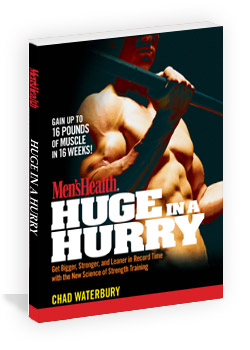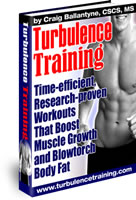Huge in a Hurry
These five new muscle rules will make you bigger, leaner, and stronger—in less time than ever before.
By Chad Waterbury, Men's Health
Ask the average guy in the average gym how to build bigger muscles, and chances are he'll tell you to do exactly what he's doing: lots of sets and reps of lots of redundant exercises. Except ... well, you notice it's not working particularly well for him. Worse, you realize you're already doing workouts similar to his, and it's not happening for you, either.
Speaking as a guy who trains world-class athletes for a living, I can tell you that the old playbook doesn't work for most people who use it—it's the fitness equivalent of "three yards and a cloud of dust." There's a better, faster, more streamlined way to get bigger, leaner, and stronger. Think of these five principles of size—borrowed from my upcoming book, Men's Health Huge in a Hurry (Rodale, 2008)—as the spread offense for gym rats.
1. Lift big to grow big.
The longer you've been lifting weights, the heavier the weights need to be in order for you to see results. On one hand, it's a stupidly obvious point—of course you use bigger weights as you become stronger. But that's not exactly what I'm talking about. When you were a beginner, you could gain size and strength as long as the weight you used on any given exercise was at least 60 percent of the amount you could lift for a single max-effort repetition. It's a weight you could lift 15 to 20 times in a single set. By any definition, that's pretty light. That percentage, though, increases with experience. Most gym regulars need to use at least 80 percent of their one-rep max to grow bigger and stronger. Now, we're talking about a weight you could probably lift about eight times in an all-out set before there's nothing left in your tank.
Be honest: Do you really use weights heavy enough to fall into that range? If you typically perform multiple sets of eight to 10 repetitions for each exercise, you don't. To use 80 percent of your max for three or four sets, each set would probably consist of five or six repetitions. It becomes even harder from there. If you're beyond the intermediate stage—if you're a serious gym rat and have been lifting consistently for much of your adult life, you might need 85 to 90 percent of your one-rep max to see genuine progress. In a normal workout with multiple sets of each exercise, we're talking about two, three or four repetitions per set. You can see the problem: Nobody can lift near-max weights on every exercise of every workout. You'd either burn out or hurt yourself, and it wouldn't take long. Fortunately, there is one loophole.
2. Lift fast to get big.
You know you're supposed to lift weights slowly and deliberately and under control. I have no problem with the "under control" part—good form requires it. But I want to take serious issue with "slowly and deliberately." The faster you lift, the better the results. If you're trying to increase size, fast lifts activate more of the muscle fibers that have the most potential to grow. If you're trying to become leaner, fast lifts do more to crank up your heart rate—and by extension your metabolism—than anything else. And if you're trying to grow stronger ... well, how many feats of strength can you list that are performed slowly and deliberately? Even if something looks slow from the outside, you can bet that the guy performing the feat is trying like hell to get it done as fast as possible. Anything worth lifting is worth lifting fast,as long as you control the weight and don't let it control you. That means you'll lower the weight a bit more slowly than you lifted it. You don't have to lower it at any particular tempo; just make sure you return it to the starting position without dropping it or shifting your body out of proper alignment.
3. Quit when you're ahead.
A fast lift with a heavy weight uses more muscle fibers than a slower lift with a lighter weight. But those big, strong muscle fibers poop out really fast—usually in 15 seconds or less. Once they've quit on you, you're left to struggle with the weight using fibers that aren't up to the task. Your body has two ways of tipping you off: 1. The speed of your repetitions slows. 2. Your form changes, and you either shorten your range of motion or have to cheat to accomplish the full range. At that point, it makes more sense to end the set than to keep going with compromised speed or bad form. I say that knowing it's one of the most unnatural things I could ask you to do in the weight room. After all, if the goal is to do sets of 8 reps and your speed slows down on the sixth, it takes discipline to end the set before grinding and shaking through those seventh and eighth reps. And it works only if you're also willing to follow Principle 4.
4. Don't sweat the small sets.
Every page of the old muscle-building playbook includes some prescription for sets and reps: a fixed number of sets of each exercise and a fixed number of reps in each set. But if you follow Principle 3 and quit each set when your speed slows down or your form changes, you can't complete a fixed number of repetitions. The new playbook says this: Focus on total reps for each exercise, and let the sets take care of themselves. Say you're doing a workout that specifies five sets of five reps. That's 25 reps total. Now let's say you use my method of doing all your reps perfectly: It might take you six sets instead of five to hit your 25-rep goal. The reward is a better workout, because you're doing more work with your biggest, strongest muscle fibers.
5. Think big to grow big.
My final revision of the weight-lifting playbook makes it dramatically shorter and lighter: I've eliminated almost all the exercises that work only small muscles or single muscle groups in isolation. Instead, my workouts begin and end with the exercises that work your biggest muscles, with the goal of working as many of them as possible every time you lift. Each workout is built around one lower-body exercise—squats, deadlifts, lunges, or step-ups—and two upper-body exercises, one for pushing and one for pulling. Gone are the leg extensions and biceps curls. If you're wondering how you're supposed to build big arms without curls, I have a simple assignment for you: Grab a chin-up bar and try to pull yourself up without using your biceps. Impossible, right? So if you work your biceps with chin-ups or lat pulldowns, using an underhand grip, or any type of rowing exercise, why would you need to do curls? What benefit does a curl offer that you can't achieve with a chinup or row? As a bonus, you burn a lot more calories when you train your biggest muscles. The greatest surprise isn't that these new-school workouts give you more benefits with less time in the gym. It's amazing that the old-style playbook survived as long as it did.
For more cutting-edge workouts and no-nonsense training advice, order your copy of Men's HealthHuge in a Hurry, by Chad Waterbury, at mhhugeinahurry.com.
Tuesday, March 31, 2009
Monday, March 30, 2009
Something wicked this way comes.
Whew! I did my first HIAH workout this AM.
I'm really having a hard time wrapping my head around this one. The workout doesn't look intimidating on paper, and even when doing it, you don't really feel that it is overwhelming.
The standing cable rows were tricky to figure out, but I didn't feel like I was using enough weight at the time. I used 140lbs and I was constantly hitting 5 or 6 reps w/ perfect speed. But as I sit here a few hours later, I KNOW I did them correctly. My upper back has never felt so worked.
I knew that BW dips wouldn't be challenging, so I loaded the belt w/ a 45lb plate and went to work. That hit the sweet spot. I did 6 reps on the first set and dropped off from there, but averaged 4 reps per set. I'll up the weights next week and see if I can maintain the same tempo.
I was feeling pretty good when I got to the DB split squats. I tried to start a little on the conservative side, so I used 55lb DBs. That was right on target as well. Speed was good. Averaged 5 reps for my stronger leg, so I need to restrict that to the number that I get on my weak leg first.
I may need to stop by the gym for some Sauna time on the way to work tomorrow.
I'm really having a hard time wrapping my head around this one. The workout doesn't look intimidating on paper, and even when doing it, you don't really feel that it is overwhelming.
The standing cable rows were tricky to figure out, but I didn't feel like I was using enough weight at the time. I used 140lbs and I was constantly hitting 5 or 6 reps w/ perfect speed. But as I sit here a few hours later, I KNOW I did them correctly. My upper back has never felt so worked.
I knew that BW dips wouldn't be challenging, so I loaded the belt w/ a 45lb plate and went to work. That hit the sweet spot. I did 6 reps on the first set and dropped off from there, but averaged 4 reps per set. I'll up the weights next week and see if I can maintain the same tempo.
I was feeling pretty good when I got to the DB split squats. I tried to start a little on the conservative side, so I used 55lb DBs. That was right on target as well. Speed was good. Averaged 5 reps for my stronger leg, so I need to restrict that to the number that I get on my weak leg first.
I may need to stop by the gym for some Sauna time on the way to work tomorrow.
Sunday, March 29, 2009
Trying something new

I purchased Chad Waterbury's book "Men's Health Huge in a Hurry" a few weeks back. I've since read it a couple of times and I'm ready to give it a go.
It is based on the protocol of lifting heavy weights while using a fast tempo to generate enough force to incorporate both muscle types. He suggest various rep ranges in each workout, with the rule of stopping the set when your rep speed or range of motion decreases. There's quite a bit of science behind Chad's philosophy, and his theory has really captured my interest.
I will be following the hypertrophy program with the goal of adding 10 lbs of muscle in 16 weeks. There's actually a 3 week preparation phase, but I'm not sure what kind of progress to expect during that phase.
Tomorrow's workout will be the first workout of the Get Ready program. Stay tuned... this should be fun!
Subscribe to:
Posts (Atom)


